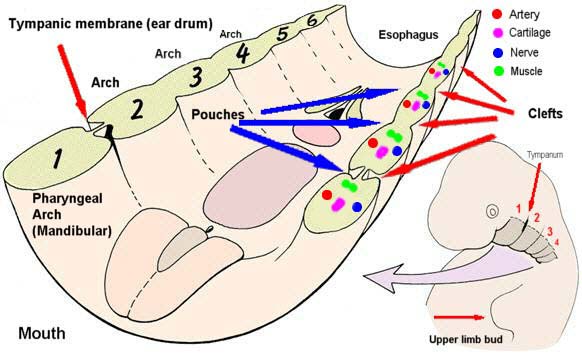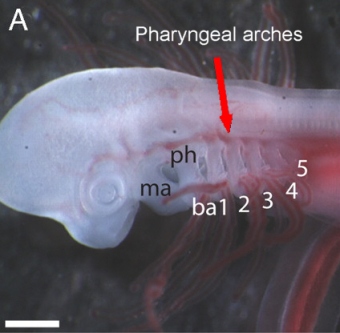First some context. Back in 2012 I wrote an article on yet another benighted creationist attack on 19th century zoologist Ernst Haeckel, written by The Institute for Creation Research’s (hereafter ICR) Dr. Brian Thomas, (Thomas 2012) implying that Haeckel—and some comparative embryology plates from the 3rd edition of his book The Evolution of Man (1874)—are responsible for the idea that the embryos of tetrapods (terrestrial vertebrates) at one point in their development posses structures often commonly referred to as “gill slits”, more properly pharyngeal clefts and pouches.
This is of course utter nonsense, as I have written on this extensively in other posts (see related links below); however embryological pharyngeal structures are not the real point here. Rather it is a quote, or I should say misquote, cited by Thomas, from a textbook, Biology (2007), authored by Sylvia Mader and a “correction” ICR has made in an editor’s note since added to his article.
In his article Thomas uses the “quote” in question—and Mader’s use of comparative embryo illustrations based, at least in part, on Haeckel’s—to imply that Mader is A) unjustifiably interpreting embryological evidence as being supportive of evolutionary theory, and B) That she isn’t up to date on the true state of comparative vertebrate embryology and Haeckel’s “discredited” illustrations.
First Thomas’s mangled quote of Mader:
Thomas: Mader wrote:
At some time during development all vertebrates have a postanal tail [spinal cord-like scaffold] and exhibit paired pharyngeal pouches… In humans, the first pair of pouches becomes the tonsils, while the third and fourth pairs become the thymus and parathyroid glands. Why should terrestrial vertebrates develop and then modify such structures like pharyngeal pouches that have lost their original function? The most likely explanation is that fishes are ancestral to other vertebrate groups.3
But how does Mader know that the pouches “lost original function?” She doesn’t—she makes the statement on the basis of evolutionary belief, not on scientific observation. She even lists the pouches’ critical functions for human development. Since the pouches are tissues organized into folds and have known functions, then there is no scientific reason to even suspect that they reflect any evolutionary past.3
Now Mader’s quote with some context and significant parts mysteriously missing or altered from Thomas’s version (the parts of significance missing/altered in Thomas’ version in boldface):
The homology shared by vertebrates extends to their embryological development (Fig. 17.16). At some time during development, all vertebrates have a postanal tail and exhibit paired pharyngeal pouches. In fishes and amphibian larvae, these pouches develop into functioning gills. In humans, the first pair of pouches becomes the cavity of the middle ear and the auditory tube. The second pair becomes the tonsils, while the third and fourth pairs become the thymus and parathyroid glands. Why should terrestrial vertebrates develop and then modify structures like pharyngeal pouches that have lost their original function? The most likely explanation is that fishes are ancestral to other vertebrate groups. (Mader 2007, p. 296)
As I noted in my previous post on Thomas’s article, he replaces Mader’s reference to the fact that the pharyngeal apparatus of vertebrate embryos develop into functioning gills in not only fish but also the larva of amphibians as well, with three little dots (beware creationists bearing ellipses…!). I think it is fair to speculate that Thomas does this due to the fact that these functioning gills in amphibians inconveniently bridges a gap between gilled fish and fully terrestrial, air breathing, vertebrates; something he would rather not have his readers contemplate.
This omission, as we will see, is not mentioned in the more recently added editor’s note.
In the second boldfaced part of the correct Mader quote we see that Thomas somehow altered the quote to make Mader wrongly say that the first pair of pharyngeal pouches are modified during development to become tonsils, rather than the middle ear and auditory tube (eustachian tube). On the other hand it is in fact the second pharyngeal pouches that gets modified into the tonsils.
All this has been merely the backdrop for the quote from Mader’s Biology (2007), Thomas’s mangling of said quote and ICR’s “correction” of Thomas’s mangle. Somehow in the intervening year since I pointed out the problems with Thomas quote or Mader—and I don’t know if it was my pointing it out that caused it—an editor of the ICR’s website became aware of Dr. Thomas’s little oopsie on which pharyngeal pouch becomes what, and decided to add a face saving note correcting the error, however the devil is in the details of this “correction”:
Editor’s note: Updated embryology specifies that the first pair of embryo pouches develops into the middle ear, not the tonsils as the above Mader quote states. “The first pair of pharyngeal pouches become the auditory cavities of the middle ear and the associated eustachian tubes. The second pair of pouches gives rise to the walls of the tonsils.” (Gilbert, S. 2014. Developmental Biology, 10th ed. Sunderland, MA: Sinauer Associates, Inc., 478.)5
Here we learn that “Updated embryology” has created a need to correct misinformation stated in the “Mader quote” on the developmental destiny of the first pharyngeal pouches. That would be the quote where Mader provided accurate information in her textbook which was then mangled by Thomas while conveying it to his audience.
It’s not Thomas’s fault you see, it is because Mader needed to be “updated”.
How contemptible do you have to be to first butcher a quote from a scholar and then when your malfeasance is pointed out to imply that it is the scholar’s information that is at issue rather than your honesty and/or competency?
Update: Having gone back and looked at Thomas’s article I realized that despite the editor’s note correcting the misinformation about the first pharyngeal pouch (arch?), the misquote of Mader has not been corrected. This leads me to speculate that they (whomever at ICR added the note) haven’t actually figured out that Thomas screwed up the quote.
Top notch stuff.
Related Links
“Creationist foists “fraudulent” embryo picture on his readers” (2012) by Troy Britain
“Gill slits” by any other name…” (2012) by Troy Britain
“Responding to a comment on my article: “Gill slits” by any other name…” (2016) by Troy Britain
“Haeckel’s ABC of evolution and development” (2002) by Michael Richardson & Gerhard Keuck
“Ernst haeckel’s ontogenetic recapitulation: irritation and incentive from 1866 to our time” (2002) by Klaus Sander
“Pictures of Evolution and Charges of Fraud Ernst Haeckel’s Embryological Illustrations” (2006) by Nick Hopwood
“Accuracy in embryo illustrations” (2008) by the National Center for Science Education
“Haeckel’s embryos: fraud not proven” (2009) by Robert J. Richards
References
Haeckel, Ernst (1874) The Evolution of Man
Mader, Sylvia S. (2007) Biology (9th ed.), McGraw-Hill
Thomas, Brian (2012) Do People Have ‘Gill Slits’ in the Womb?, ICR website accessed on 3-17-2024















